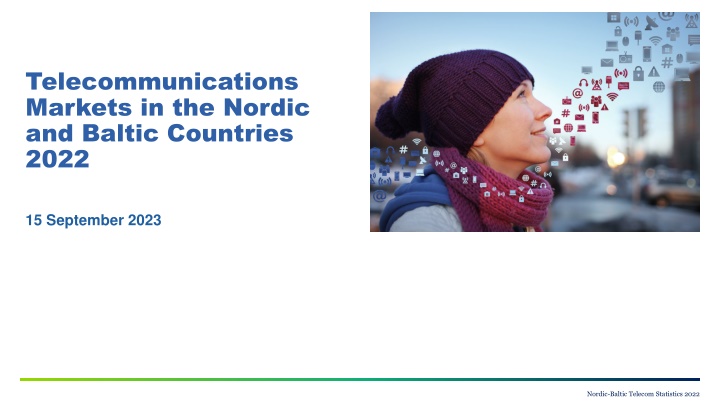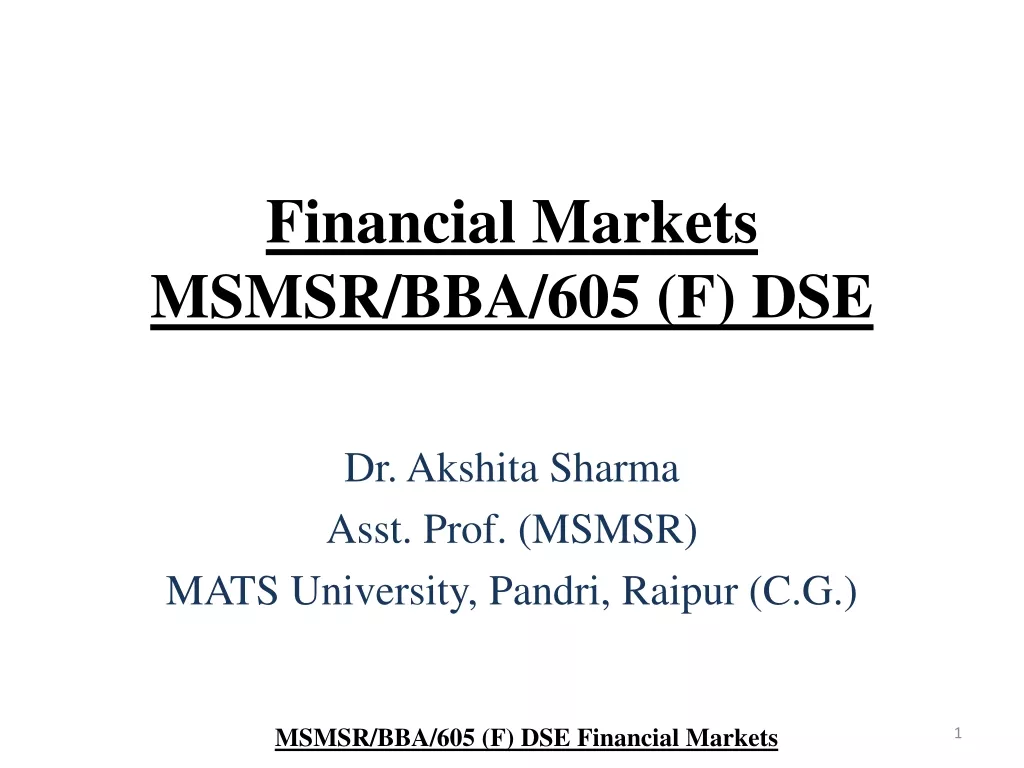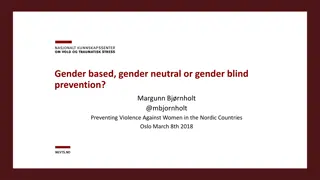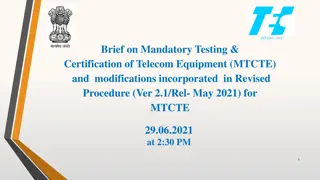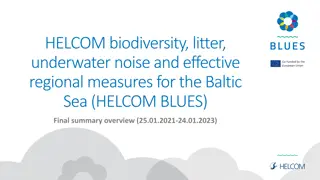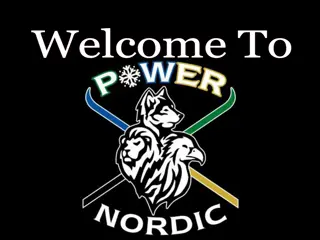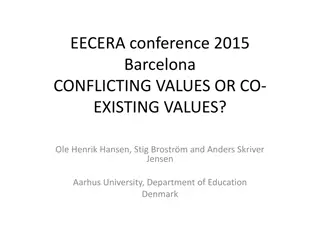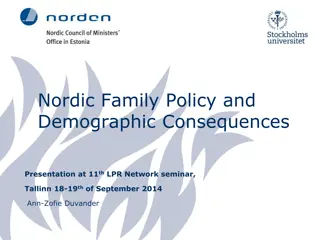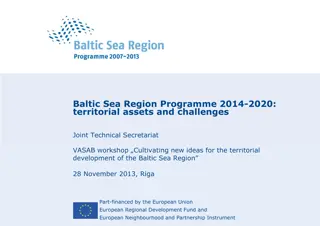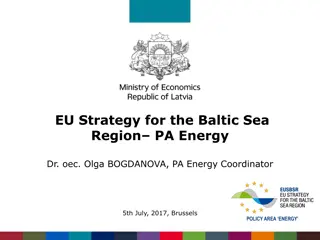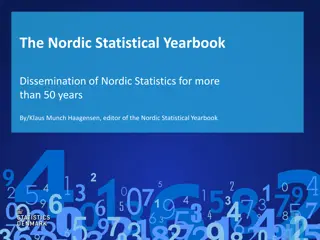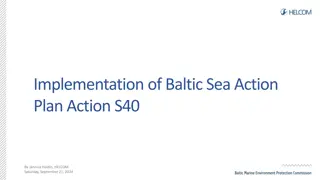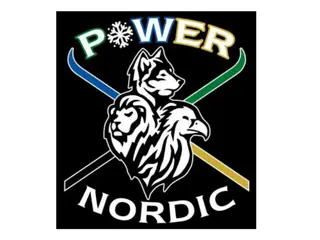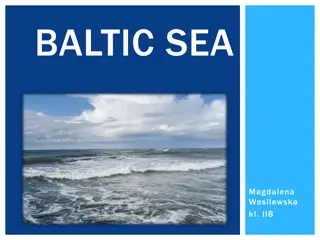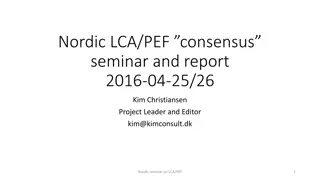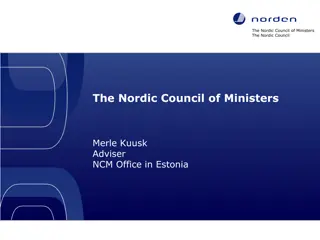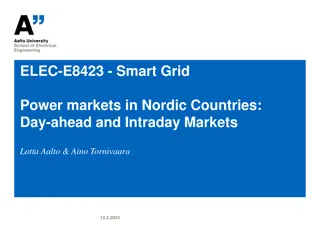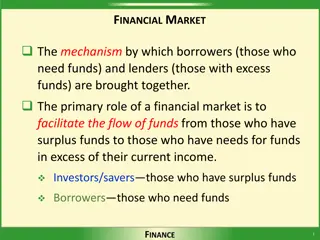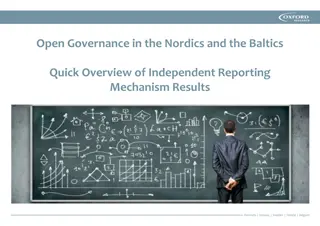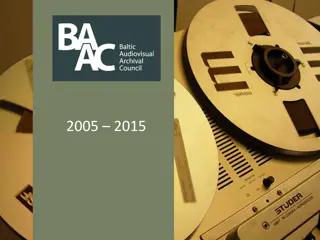Telecom Markets in the Nordic and Baltic Countries 2022
This publication provides insights into the telecommunications markets in the Nordic and Baltic countries covering data from 2017 to 2022. It includes details on population trends, mobile services, and statistics validated by the Nordic-Baltic working group. Explore variations in mobile subscriptions, call minutes, and data volumes per capita across different countries.
Download Presentation

Please find below an Image/Link to download the presentation.
The content on the website is provided AS IS for your information and personal use only. It may not be sold, licensed, or shared on other websites without obtaining consent from the author.If you encounter any issues during the download, it is possible that the publisher has removed the file from their server.
You are allowed to download the files provided on this website for personal or commercial use, subject to the condition that they are used lawfully. All files are the property of their respective owners.
The content on the website is provided AS IS for your information and personal use only. It may not be sold, licensed, or shared on other websites without obtaining consent from the author.
E N D
Presentation Transcript
Telecommunications Markets in the Nordic and Baltic Countries 2022 15 September 2023 Nordic-Baltic Telecom Statistics 2022
About the database The database was established in 2007 by the Nordic countries. The Baltic States are included since the spring of 2013. Consists of selected variables that are comparable between the countries. A dynamic database that will change as the telecom markets develop. The figures are collected and validated by the Nordic-Baltic working group on statistics and definitions. Unless otherwise stated, the sources for all figures are the national regulatory agencies and/or the national statistical agencies of each country. Graphs included in this publication cover the years 2017 2022. Previous years are available in the database only. The variables are stated as of the end of the year. Time series for each country are displayed from the year where data are available. Due to this, the length of time series may vary. Graphs include both private and business customers unless otherwise stated. The graphs are usually expressed as per capita or per household, which means the amount of each variable (both private and business) divided by the relevant country s population or number of households. For more information, see the PTS statistics portal: http://statistik.pts.se/nordic-baltic-telecom-market/ Nordic-Baltic Telecom Statistics 2022
Population Population (in thousands) as of year end in the Nordic and Baltic countries. As most of the graphs in this presentation are scaled based on the population in each country, it should be noticed that the population is growing in some countries while decreasing in others. In this publication only the population figures from 2017 to 2022 are shown. Population 2017 2018 2019 2020 2021 2022 Change 2017 - 2022 Denmark 5 781 5 806 5 823 5 840 5 850 5 933 3% Estonia 1 316 1 325 1 329 1 330 1 332 1 366 4% Finland 5 510 5 518 5 525 5 534 5 548 5 566 1% Iceland 348 357 364 369 376 388 11% Latvia 1 934 1 920 1 908 1 893 1 876 1 883 -3% Lithuania 2 809 2 794 2 794 2 796 2 806 2 860 2% Norway 5 296 5 328 5 368 5 391 5 425 5 445 3% Sweden 10 120 10 230 10 328 10 379 10 452 10 522 4% Nordic-Baltic Telecom Statistics 2022
1. Mobile services Nordic-Baltic Telecom Statistics 2022
Mobile services The largest number of mobile SIM cards per capita was in Estonia - 1.99. Notably, this indicator increased significantly only in Estonia and Lithuania during the analyzed period. In other countries, it remained relatively constant. The countries mobile voice and data subscriptions per capita increase yearly. The values of this indicator do not differ significantly between countries. The number of mobile call minutes grew significantly in all countries in 2020 2021 but decreased in 2022. This criterion highly reflected the effect of covid19 on the electronic communications sector and the way back to normal life . Finland had by far the largest mobile data volumes, 63,3 Gbyte per capita a month. The popularity of subscriptions without data caps and the use of mobile subscriptions as household broadband are essential factors behind this development in Finland. Mobile data traffic grew fast in all countries, especially Latvia and Estonia. The number of machine-to-machine (M2M) SIM cards was growing in all the countries. M2M SIM cards per capita are highest in Norway, followed by Sweden. Most M2M SIM cards with Swedish and Icelandic numbers are used outside the country. Nordic-Baltic Telecom Statistics 2022
1.1 Mobile subscriptions per capita Number of mobile subscriptions (GSM/UMTS/LTE/5G) for voice and data divided by population. Pre-paid subscriptions are included and must have been active within the last 3 months of the period. M2M subscriptions are not included. 1.99 2.00 1.75 1.67 1.63 1.47 1.50 1.40 1.36 1.35 1.25 1.15 1.00 0.75 0.50 0.25 0.00 Denmark Estonia Finland Iceland Latvia Lithuania Norway Sweden 2017 2018 2019 2020 2021 2022 Nordic-Baltic Telecom Statistics 2022
1.2 Number of mobile voice and data subscriptions per capita Subscriptions where both mobile data and voice are included. Excludes data add-on subscriptions and dedicated mobile data subscriptions. 1.5 1.26 1.21 1.18 1.2 1.14 1.05 1.00 0.98 0.97 0.9 0.6 0.3 0.0 Denmark Estonia Finland Iceland Latvia Lithuania Norway Sweden 2017 2018 2019 2020 2021 2022 Nordic-Baltic Telecom Statistics 2022
1.3 Mobile call minutes per capita in a month Most of the mobile subscriptions today include unlimited minutes or at least a very large number of minutes. The figures exclude international roaming. 360 310 300 280 272 259 257 246 239 235 240 180 120 60 - Denmark Estonia Finland Iceland Latvia Lithuania Norway Sweden 2017 2018 2019 2020 2021 2022 Nordic-Baltic Telecom Statistics 2022
1.4 Data transferred over mobile networks per capita in a month (Gbytes) Includes both uploaded and downloaded traffic. Data roaming is not included. Calculated by the binary system (1 GB = 10243B). 70 63.3 60 49.1 50 42.8 40 34.1 27.9 30 26.7 24.4 20 10.4 10 0 Denmark Estonia Finland Iceland Latvia Lithuania Norway Sweden 2017 2018 2019 2020 2021 2022 Nordic-Baltic Telecom Statistics 2022
1.5 Machine-to-machine (M2M) SIM cards per capita Includes SIM cards sold specifically to be used with or between machines in, for example, energy consumption meters, cars and surveillance cameras. The 2019-2022 figure for Sweden and 2021-2022 for Iceland is based on the estimated number of M2M SIM cards used within the country. 0.72 0.75 0.58 0.60 0.45 0.37 0.34 0.31 0.30 0.26 0.25 0.24 0.15 0.00 Denmark Estonia Finland Iceland Latvia Lithuania Norway Sweden 2017 2018 2019 2020 2021 2022 Nordic-Baltic Telecom Statistics 2022
2. Fixed call services Nordic-Baltic Telecom Statistics 2022
Development of fixed call services Fixed telephony subscription per capita decreases every year in all of the countries. Even Covid19 did not have a significant effect on this trend. Covid19 slowed the decrease of the number of fixed call minutes in all countries. The value of this indicator even increased a little bit in Denmark and Lithuania in 2020 but continue decreasing in 2021 and 2022. The Latvian and Icelandic incumbents plan to gradually switch their entire fixed networks over to IP technology and eventually shut down the PSTN networks. IP telephony is often bundled with other services such as fixed broadband and TV. In those cases, the IP telephony part of the bundle may be inactive. Nordic-Baltic Telecom Statistics 2022
2.1 Fixed telephony subscriptions per capita Includes PSTN, ISDN and IP telephony. The figures include both business and private subscriptions, which may differ significantly in terms of traffic generated, since a business customer may have many users of the same fixed telephony connection (e.g., ISDN). 0.40 0.35 0.30 0.24 0.25 0.20 0.15 0.12 0.10 0.09 0.09 0.10 0.06 0.05 0.03 0.03 0.00 Denmark Estonia Finland Iceland Latvia Lithuania Norway Sweden 2017 2018 2019 2020 2021 2022 Nordic-Baltic Telecom Statistics 2022
2.2 Fixed call minutes per capita in a month The Danish incumbent, TDC, had a change of definition from 2017 to 2018. 75 60 45 28.7 27.7 30 23.2 15 11.1 10.0 8.4 5.5 4.1 0 Denmark Estonia Finland Iceland Latvia Lithuania Norway Sweden 2017 2018 2019 2020 2021 2022 Nordic-Baltic Telecom Statistics 2022
3. Broadband services Nordic-Baltic Telecom Statistics 2022
Development of broadband services Estonia, Finland, and Denmark had the highest numbers of total broadband subscriptions recalculated per capita in 2022. This indicator includes subscriptions of all kinds of fixed and mobile (e.g., mobile broadband in smartphones, dedicated data) broadband except M2M connection. Finland and Denmark showed the best results by subscriptions of broadband usually used at fixed locations fixed broadband and mobile dedicated data broadband in 2022. The value of this indicator exceeded 0,7 subscriptions per capita in these countries. Norway gained a leading position talking about fixed broadband subscriptions per household in 2022, but Iceland remained a leading country by indicators of broadband subscriptions with data download speeds of 30, 100 Mbps, and 1 Gbps per household. The share of fiber subscriptions of all fixed broadband subscriptions was highest in Iceland and Sweden, exceeding 80 percent in 2022. When combining fiber and cable subscriptions per capita, Norway, Sweden, and Denmark had the highest penetration rate with relatively 0,41; 0,39, and 0,37. The combined penetration rate for cable and fiber was increasing in all countries, mostly due to growth in fiber subscriptions. Nordic-Baltic Telecom Statistics 2022
3.1 Number of total broadband subscription per capita Includes mobile and fixed broadband subscription. M2M subscription is not included. 2.1 1.99 1.94 1.92 1.73 1.8 1.58 1.58 1.48 1.44 1.5 1.2 0.9 0.6 0.3 0.0 Denmark Estonia Finland Iceland Latvia Lithuania Norway Sweden 2017 2018 2019 2020 2021 2022 Nordic-Baltic Telecom Statistics 2022
3.2 Number of fixed and mobile dedicated data broadband subscriptions per capita The mobile dedicated data broadband services are typically used via a dongle, tablet or mobile router. 0.8 0.73 0.70 0.64 0.58 0.6 0.55 0.53 0.50 0.47 0.4 0.2 0.0 Denmark Estonia Finland Iceland Latvia Lithuania Norway Sweden 2017 2018 2019 2020 2021 2022 Nordic-Baltic Telecom Statistics 2022
3.3 Fixed broadband subscriptions per household Values of indicator went down in Iceland and Sweden because the population and number of households grew faster than fixed broadband subscriptions in these countries. 1.2 0.96 0.95 1.0 0.95 0.87 0.78 0.8 0.68 0.59 0.59 0.6 0.4 0.2 0.0 Denmark Estonia Finland Iceland Latvia Lithuania Norway Sweden 2017 2018 2019 2020 2021 2022 Nordic-Baltic Telecom Statistics 2022
3.4 Fixed broadband subscriptions with a marketed downstream capacity of 30 Mbps or more, per household The value of indicator went down in Iceland because the population and number of households grew faster than fixed broadband subscriptions in this country. 1.2 1.0 0.94 0.85 0.83 0.83 0.8 0.59 0.6 0.52 0.48 0.47 0.4 0.2 0.0 Denmark Estonia Finland Iceland Latvia Lithuania Norway Sweden 2017 2018 2019 2020 2021 2022 Nordic-Baltic Telecom Statistics 2022
3.5 Fixed broadband subscriptions with a marketed downstream capacity of 100 Mbps or more, per household 0.90 0.82 0.80 0.73 0.72 0.75 0.60 0.45 0.41 0.37 0.37 0.30 0.25 0.15 0.00 Denmark Estonia Finland Iceland Latvia Lithuania Norway Sweden 2017 2018 2019 2020 2021 2022 Nordic-Baltic Telecom Statistics 2022
3.6 Fixed broadband subscriptions with a marketed downstream capacity of 1 Gbps or more, per household 0.50 0.45 0.45 0.40 0.35 0.30 0.24 0.25 0.20 0.15 0.10 0.06 0.05 0.05 0.02 0.02 0.01 0.00 0.00 Denmark Estonia Finland Iceland Latvia Lithuania Norway Sweden 2017 2018 2019 2020 2021 2022 Nordic-Baltic Telecom Statistics 2022
3.7 Share of fiber subscriptions of total fixed broadband subscriptions Fiber includes both FTTH and FTTB. There was a change of definitions in Finland in 2017. 90% 82% 81% 79% 80% 75% 70% 70% 63% 60% 49% 48% 50% 40% 30% 20% 10% 0% Denmark Estonia Finland Iceland Latvia Lithuania Norway Sweden 2017 2018 2019 2020 2021 2022 Nordic-Baltic Telecom Statistics 2022
3.8 Fixed broadband subscriptions via fiber and cable networks per capita Fiber and cable will be key to meeting the EU s broadband target that all households should have access to networks offering a download speed of at least 100 Mbps, which can be upgraded to 1 Gbps, in 2025. 0.45 0.41 0.39 0.40 0.37 0.35 0.31 0.30 0.30 0.23 0.25 0.23 0.20 0.20 Fiber 0.15 Cable TV 0.10 0.05 0.00 2018 2021 2022 2017 2017 2019 2020 2021 2022 2017 2018 2019 2020 2021 2022 2017 2018 2019 2020 2021 2022 2017 2018 2019 2020 2017 2018 2019 2020 2021 2022 2017 2018 2019 2020 2021 2022 2017 2018 2019 2020 2021 2022 2018 2019 2020 2021 2022 Denmark Estonia Finland Iceland Latvia Lithuania Norway Sweden Nordic-Baltic Telecom Statistics 2022
3.9 Share of fixed broadband subscriptions with a marketed downstream capacity of 100 Mbps or more of total fixed broadband subscriptions 100% 92% 86% 77% 80% 75% 70% 63% 60% 54% 40% 32% 20% 0% Denmark Estonia Finland Iceland Latvia Lithuania Norway Sweden 2017 2018 2019 2020 2021 2022 Nordic-Baltic Telecom Statistics 2022
4. TV services Nordic-Baltic Telecom Statistics 2022
Development of traditional pay-TV services IPTV was the most popular pay-tv technology in all countries except Sweden and Denmark. IPTV penetration was highest in Iceland, where there is no satellite TV, and in Norway. In 2022, there were 0,23 IPTV subscriptions per capita in these countries. IPTV includes both DSL and fiber platforms. Nordic-Baltic Telecom Statistics 2022
4.1 Number of IPTV subscriptions per capita Denmark did not provide data of 2021-2022. 0.35 0.30 0.25 0.21 0.21 0.20 0.17 0.16 0.15 0.13 0.11 0.11 0.10 0.05 0.00 Denmark Estonia Finland Iceland Latvia Lithuania Norway Sweden 2017 2018 2019 2020 2021 2022 Nordic-Baltic Telecom Statistics 2022
5. Market shares Nordic-Baltic Telecom Statistics 2022
5.1 Market share of leading mobile operator Operator with the largest market share, based on subscriptions (M2M are not included). Market shares include subsidiaries. Mobile subscriptions includes all mobile voice and data subscriptions, including dedicated mobile data subscriptions. 50% 44% 43% 43% 39% 38% 40% 38% 36% 32% 30% 20% 10% 0% Denmark Estonia Finland Iceland Latvia Lithuania Norway Sweden 2017 2018 2019 2020 2021 2022 Nordic-Baltic Telecom Statistics 2022
5.2 Market share of leading operator in fixed broadband services Operator with the largest market share, based on subscriptions. 70% 60% 53% 52% 50% 50% 46% 42% 40% 34% 29% 29% 30% 20% 10% 0% Denmark Estonia Finland Iceland Latvia Lithuania Norway Sweden 2017 2018 2019 2020 2021 2022 Nordic-Baltic Telecom Statistics 2022
6. Investments and revenues Nordic-Baltic Telecom Statistics 2022
Exchange rates Revenues are given in Euros adjusted for purchasing power (EUR/PPP) to account for differences in price levels across the countries. Nominal exchange rates: Source: European Central Bank Average exchange rate: 1 January - 31 December of each year Purchasing power parity (PPP): Source: Eurostat, Purchasing power parities, price level indices and real expenditures for ESA 2010 aggregates EUR/PPP rates for each country are calculated based on price levels relative to EU27_2020=1 Nordic-Baltic Telecom Statistics 2022
6.1 Investments per capita (EUR) Investments in tangible fixed assets. 300 254.9 253.7 250 200 187.2 150 132.3 100 84.6 77.8 48.3 40.8 50 0 Denmark Estonia Finland Iceland Latvia Lithuania Norway Sweden 2017 2018 2019 2020 2021 2022 Nordic-Baltic Telecom Statistics 2022
6.2 Revenues per capita (EUR/PPP) Retail revenues from mobile call services, fixed call services, and broadband services. Revenues from TV and international roaming are not included. Revenues exclude VAT. 600 488.2 500 379.0 377.2 400 332.4 331.1 300 270.0 250.8 248.8 200 100 0 Denmark Estonia Finland Iceland Latvia Lithuania Norway Sweden 2017 2018 2019 2020 2021 2022 Nordic-Baltic Telecom Statistics 2022
7. Broadband coverage Nordic-Baltic Telecom Statistics 2022
Definitions of broadband coverage In this publication, broadband coverage refers the proportion of households (permanent dwellings) who can get broadband access with certain characteristics. This includes households with physical broadband access ( homes connected ). It also includes households without physical broadband access that can order a broadband connection and get it installed by a broadband provider under certain, reasonable conditions ( homes passed ). Hence, the definition of broadband coverage in this publication aims to provide a measure of the total availability of broadband. The figures for Iceland and Lithuania refers only to the proportion of households with physical broadband access ( homes connected ). The calculation of broadband coverage is based on data from broadband providers in each country. Methods and definitions vary to some extent between the countries. Numbers that are close to each other should therefore not be interpreted as significant differences in coverage. Nordic-Baltic Telecom Statistics 2022
7.1 Coverage of fiber broadband, including fiber LAN (%) For Iceland and Lithuania, data refer to homes connected, for all other countries data refer to homes passed. Data for Latvia is available since 2022. 96% 100% 92% 82% 79% 80% 72% 71% 61% 60% 52% 40% 20% 0% Iceland Lithuania Denmark Estonia Finland Latvia Norway Sweden 2018 2019 2020 2021 2022 Nordic-Baltic Telecom Statistics 2022
7.2 Coverage of fixed broadband with download speed of 30 Mbps or more (%) For Iceland and Lithuania, data refer to homes connected, for all other countries data refer to homes passed. Data for Latvia is available since 2022. 99% 98% 99% 97% 100% 87% 84% 78% 80% 74% 60% 40% 20% 0% Iceland Lithuania Denmark Estonia Finland Latvia Norway Sweden 2018 2019 2020 2021 2022 Nordic-Baltic Telecom Statistics 2022
7.3 Coverage of fixed broadband with download speed of 100 Mbps or more (%) For Iceland and Lithuania, data refer to homes connected, for all other countries data refer to homes passed. Data for Latvia is available since 2022. 97% 97% 100% 94% 93% 80% 73% 73% 70% 61% 60% 40% 20% 0% Iceland Lithuania Denmark Estonia Finland Latvia Norway Sweden 2018 2019 2020 2021 2022 Nordic-Baltic Telecom Statistics 2022
More statistics of each country Denmark - https://sdfi.dk/digital-infrastruktur/telepolitik/tal-paa-teleomraadet; tjekditnet.dk; https://app.powerbi.com/view?r=eyJrIjoiMmQwYWFkMjEtNzI0OC00MjMyLWFhYzgtZWVkYjY1OWUyMDBkIiwidCI6Ij I1YTRiZTU0LTRhN2MtNGFhMS04YTgwLWJlNmY2NmJiMGUwNiIsImMiOjl9 Estonia Finland https://tieto.traficom.fi/en/viestinnasta Iceland https://www.fjarskiptastofa.is/english/markets-and-legal-affaires/market-analysis-and-statistics/ Latvia - https://www.sprk.gov.lv/content/nozares-raditaji-9 Lithuania - https://www.rrt.lt/en/istekliai/reports-and-reviews/lietuvos-rysiu-sektorius-en/ Norway Sweden - https://statistik.pts.se/ Nordic-Baltic Telecom Statistics 2022
